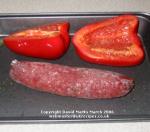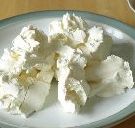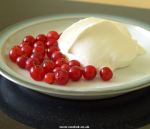|
|
|
A B
C D E
F G H
I J K
L M N
O P Q
R S
T U V
W X Y
Z
C C C C C C C C C
(page 2)
| Chipolata |
A small sausage traditionally made from pork or pork
and beef. About 8 cm (3 inches) long it's ideal as a snack on a
cocktail stick. It's also often served with roast chicken or turkey.
The word chipolata is derived from Italian for onion "cipolla". |
| Chives |
Chives are a type of onion and it's the hollow
green stems growing above ground which are most frequently used. The
stems are cut of off the plant and normally chopped for use in
salads, cheese and egg dishes or savoury dishes. They freeze very
well. The cultural Latin name for chives is Allium schoenoprasum
and they originate from north east Asia. |
Chorizo
 |
Chorizo is a Spanish sausage which contains at least
pork and pimenton (smoked paprika). From there on the varieties are endless. Often
smoked and almost always spiced and salted. Chorizo is a dried
sausage.
The wider ones can be sliced and eaten. The thinner, and
normally softer varieties are usually cooked and some can be eaten
whole. |
| Coconut
Cream |
Coconut cream is made by simmering grated coconut
(not the liquid from inside) water. After a couple of hours the
liquid is strained and is sold as coconut milk.
Normally it is sold in cartons or cans but occasionally it sold
as a hard block which can be broken down and added to the recipe. |
Cream Cheese
 |
First produced in America around 1872. This is a true cheese with a
creamy taste and texture. It is similar to the cheese Boursin.
Typically it is eaten cold on biscuits or bread with accompaniments such as smoked
salmon or prawns. Most famously it is a key ingredient of both baked and cold
cheesecakes. High in fat, there are now low fat versions. |
Creme
Fraiche
 |
Creme Fraiche is a soured thick cream. It can be
made at home by combining thick cream and either a small amount of
buttermilk or sour cream. Leave at room temperature for around 15
hours then refrigerate.
Often used in place of cream and sour cream because it will not
curdle. It also keeps for around 10 days in the fridge. It combines
well with fruits and puddings. |
| Cumin Seed |
Cumin seed is a spice used to flavour a wide variety
of dishes especially curries and meat dishes. Cumin is an important
ingredient in a chilled Indian soft drink, sometimes with tamarind
water and also in the German spirit kummel. The active ingredient in
cumin seed is cuminaldehyde It's not a hot spice but has an
earthy, slightly bitter and nutty flavour. Outside of the East,
cumin seed is normally a brown colour but in Northern India they
often cook with black cumin seed which has a more intense and
perfumed flavour.
Generally, add about a third of a teaspoon of cumin seed per
serving. Dry roasting or grilling the seeds lightly before use will
bring out more of the flavour but is by no means essential.
Use of cumin goes back more than a thousand years. The Romans
used it instead of pepper. Cumin is reputed to keep lovers faithful
and was frequently used in love potions in times gone by. It has
been used as a condiment in England from the 13th century. |
GO TO LETTER C PAGE 1
|
|
|

